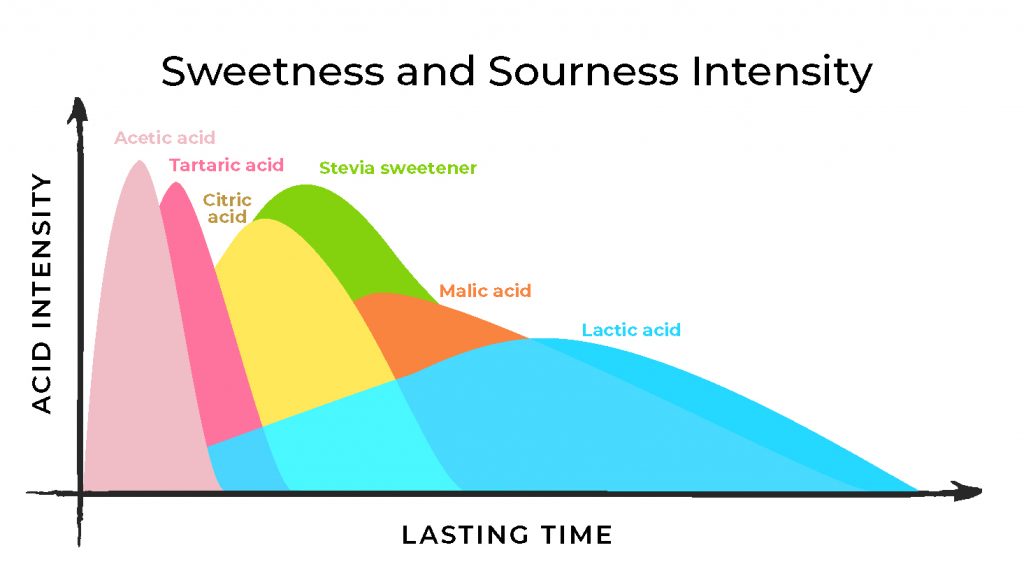When reducing or replacing sugar with stevia in a food or beverage product, formulators must always keep in mind that stevia exhibits a later onset of sweetness compared to sugar. This particular property of stevia is important when understanding how its sweetness interacts with flavors from other ingredients. A leading example is that such products commonly pair their sweetness with sour or tart flavors that are produced by a vast variety of acids. In this edition of Formulas for Success, we will focus our attention on how to best harmonize the sweetness of stevia with different types of acids in your sugar reduction formulation.
The Importance of Acid in Sweet Formulas
Aside from sugar and other sweeteners, acids are some of the most common ingredients in sweet food and beverage products. In fact, they’re found in the vast majority of formulas with a sweetener in them. As such, acids have a significant impact on the amount of sweeteners applied in such formulations. Generally speaking, the higher the amount of acid, the more sweetener is needed. Our formulation experts have found that striking that right balance does not have to be difficult, but they advise product developers to be aware that adjusting sweetener levels is not a simple one-dimensional calibration. Making such alterations will often affect other parts of the formula as well.
Citric Acid and Malic Acid With Stevia
A common acid in many sugar beverages is citric acid. The time intensity profile of citric acid (see graph below) is more upfront and similar to that of sugar. If replacing a portion or all of the sugar in a formula with stevia, the acid level or type may also need to be adjusted for an optimal sweetness profile. Some formulas may need just a slight reduction in citric acid as the upfront acid impact can taste stronger if there is less sugar to balance it out. Another option we’ve found successful is to partially replace the citric with malic acid. Since the taste impact of malic acid comes later compared to citric acid, it acts as a better balance to the sweetness of stevia. If you are noticing a lingering sweetness in your formulation with stevia, we’d recommend adding an acid that has a later taste profile to offset the linger.

Sample Stevia Formulation with Citric Acid

Below is a sweetened Iced Tea application that demonstrates how to both reduce and replace sugar entirely. In this example, a citric acid reduction helped balance out the later sweetness profile of stevia replacing sugar.
| Full Sugar | 50% Reduced Sugar | Sugar Free | |
| Water | 87.63g | 93.5275g | 99.43g |
| HFCS 42 | 11.82g | 5.91g | 0g |
| Med-Dark Instant Dark Tea Extract | 0.25g | 0.25g | 0.25g |
| Citric Acid | 0.2g | 0.195g | 0.19g |
| Lemon Lime Extract | 0.1g | 0.1g | 0.1g |
| SoPure™ Stevia Andromeda | 0g | 0.018g | 0.045g |
| Total | 100g | 100g | 100g |
Dairy Formulation with Stevia and Lactic Acid

In dairy applications, lactic acid is naturally included from milk. Since lactic has a late onset of acidity, it will help to mask some of the lingering sweetness of stevia. In our experience, our formulators have found that Reb M works very well for dairy applications. Since that glycoside offers a very clean taste profile, the lactic acid is effective for cutting the linger for a great tasting yogurt or flavored milk.
Vinaigrette Dressings & Pickled Products with Stevia
When reducing or replacing sugar with stevia in vinaigrette dressings and pickled products, adjustments to the acetic acid levels are recommended. The taste from acetic acid is likely to be rather strong as it is a very upfront acid. For such formulations, try experimenting with reducing the use levels of acetic acid to create a better balance with the sweetness of stevia.
Ready to create your own formula for success? Partner with us and learn more about other ways to optimize your stevia formulation with acids. Contact one of our expert consultants for your product development and formulation needs!



